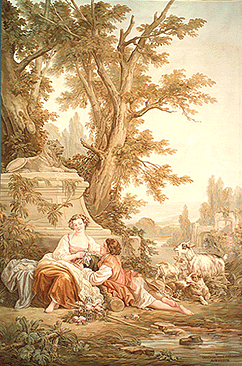
Aubusson Tapestry c. 1900 (after Boucher)
About Aubusson Antique Tapestries
Introduction
By the early twentieth century up to 2000 people were still employed in this centuries-old occupation, but the subsequent two world wars weren't exactly a boon to the hand-woven tapestry industry that once flourished in 18th century Aubusson France. Even in the aftermath of the French Revolution, and by the nineteenth century, an effective downsizing of the industry had taken place as the state took over production of the weaving facilities - and instead of the large elegant wall hangings that simulated framed classical paintings, little else but upholstery covers were being made.
The ending of the second world war effectively spurred on the modernization process and tapestry production, for the most part, became mechanized and the production of handwoven tapestries become essentially a luxury craft honoring prestigious (though increasingly rare) orders. As if to acknowledge that these exquisite pieces of handmade art had indeed become something of an endangered species, in 2009 the United Nations added Aubusson to its list of Cultural Heritage Sites.
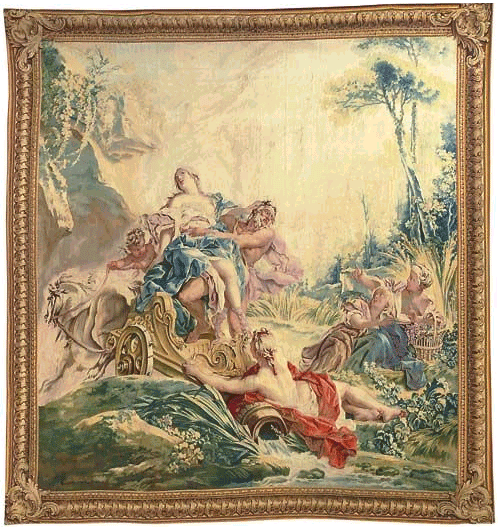
Loves of the Gods 10' × 11' tapestry after
Francois Boucher's original design for royal workshop (Beauvais, France - 1750)
18th Century French Tapestry
Illustrative tapestries with decorative surrounds initially appeared in the first quarter of the 18th century, with the History of Don Quixote - after Charles Coypel - and reached their zenith with the collaboration of Maurice Jacques and renouned French artist Francois Boucher. Combining Boucher's elegant compositions with Jacques' refined border decorations, these tapestries were considered to be the most successful and spectacular of the royal production facility at Gobelins, France.
The 18th-century French tapestry workshops were established under the general direction of the finance minister of Louis XIV, Jean-Baptiste Colbert, and set up as something of a 2-tier system: the royal Gobelins manufactury executed tapestries for the royal residences and ambassadorial perquisites, while the manufactury at Beauvais remained a private, lesser-priority, enterprise.
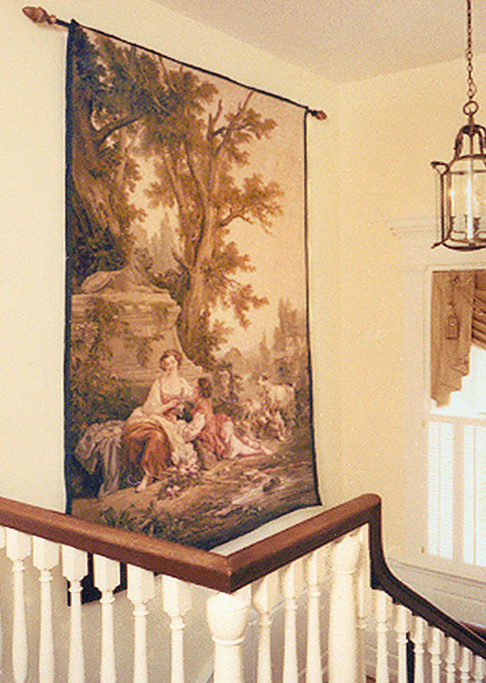
This hand-woven antique Aubusson tapestry c. 1900 was produced at
the height of a revival in French tapestry-making.
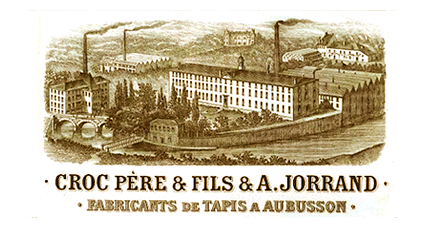
Late 19th - Early 20th Century French Tapestry
It is the period in between - about 1890 until about 1914 - that a significant resurgence in the production of the decorative monumental tapestry occurred, under the direction of artist and template-designer Antoine Jorrand - first son of one of the founders of the Aubusson production facility Crocq Pére & Fils & A. Jorrand. It was from their office at Rue du Sentier No. 20, Paris that a revival in the production of tapestries after the type produced in workshops over a century earlier - but now featuring reproductions of classic eighteenth century artworks - was launched. Artistic director Antoine Jorrand had received his artistic training under noted academician Jean-Paul Laurens - regularly exhibiting in various Salons including the Salon of French Artists and the Universal Exhibition of 1900 at a time when classical art had come under increasing scrutiny.
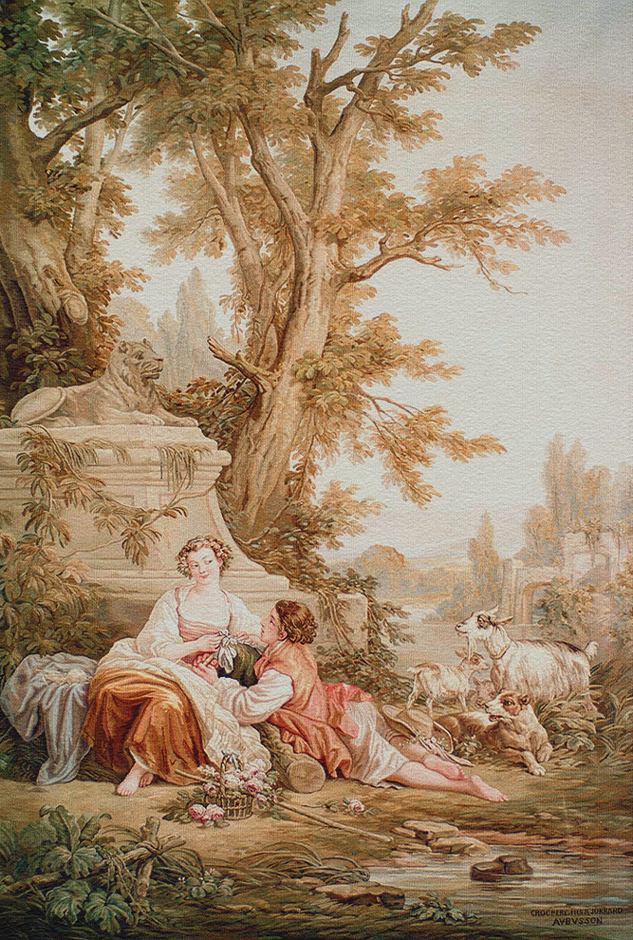
Aubusson tapestry design c. 1900 by Antoine Jorrand after the painting
La Marotte by Francois Boucher
The Boucher Tapestry - Crocq Pére & Fils & A. Jorrand
The Crocq Pére & Fils & A. Jorrand Aubusson Tapestry (above) is modelled from the Francois Boucher painting La Marotte (La Musette), or likely an alternate version of that painting (2 different versions are shown below).
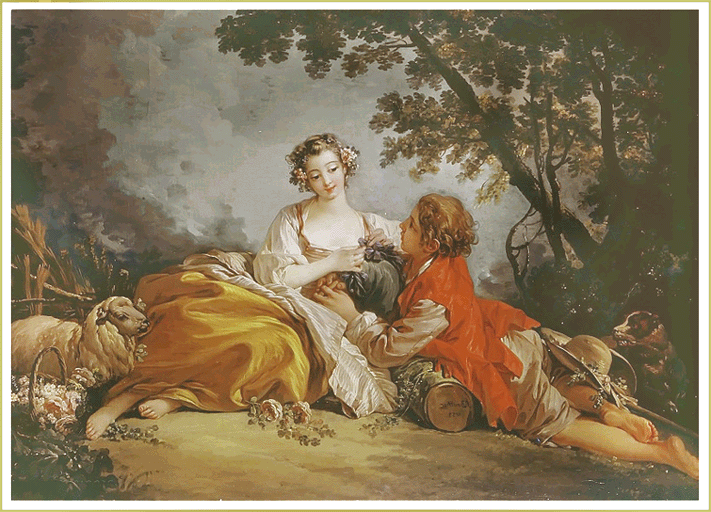
The painting La Marotte (La Musette), 1759, by Francois
Boucher in the Museum at the Palace of Versailles.
Apparently Boucher had painted at least 2 versions - one version, which at some point had been on display at the Louvre, was quite likely the one that Jorrand had used to create his template from, since the face of the girl in the tapestry more closely resembles the one in the painting (below). Jorrand has copied the girl, the shepherd boy
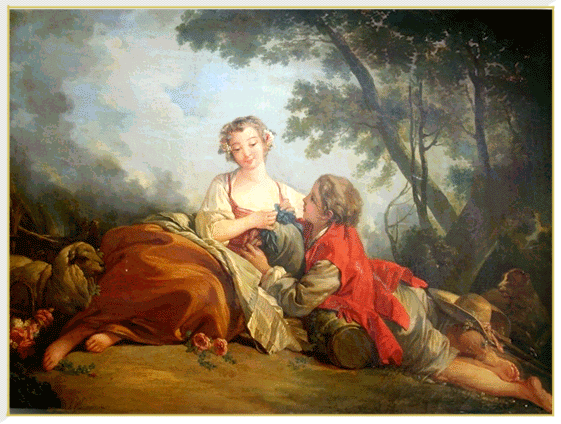

The Project Gutenberg
Boucher Masterpieces in Colour Series - Haldane Macfall www.gutenberg.org
and the dog - and surrounding elements like the tree stump, the 2 flowers on the ground and the hat - verbatim. Other than that Boucher's original composition has undergone modification: not only has the horizontal landscape format been transformed to vertical, or portrait, format, but the composition has been rotated horizontally as well so that the tapestry is now in mirror-symmetry relation to the painting (NOTE: The 2 examples shown here have also been rotated horizontally to conform with the tapestry). The new background - either composed by Jorrand or sourced from another painting - perfectly compliments Boucher's foreground arrangement.
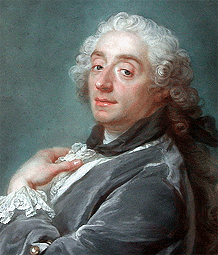
"Boucher is one of those men who represent the taste of a
century, who express, personify and embody it."
- Goncourt Brothers
François Boucher
From 1736 to 1755 Francois Boucher designed tapestries for the royal workshops at Beauvais including six series of 45 tapestries - of those, the Noble Pastorale series are the most commonly available today. These monumental original works could reach twelve feet high by nineteen feet long and typically portrayed fashionably-dressed shepherds and shepherdesses engaged in outdoor romantic pursuits.
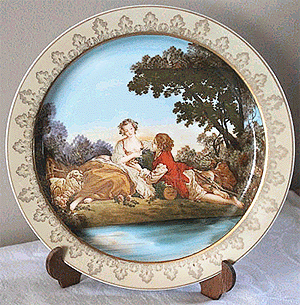
Boucher's popularity resulted in many engravings from his drawings
as well as reproduction of his themes onto porcelain.
As innovative as he was prolific, Francois Boucher was the most-celebrated French painter of the early to mid 18th century. The leading exponent of the fashionable Mythologie Galante, his style was the embodiment of what came to be known as Rococo - even so, a distinctly classical element is prevalent throughout his art. After winning the elite Grand Prix de Rome, and upon his return from studying in Italy in 1731, he was admitted to the Royal Academy of Painting and Sculpture first, as historical painter - and later as Director - subsequently being appointed in 1765 First Painter to the King.
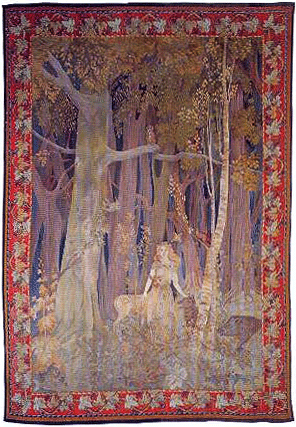
"Tapestry - it must be a fable or legend on the wall!"
- Antoine Jorrand
Textile Art Reproduction
In 1742 Boucher's oil sketches from the Beauvais workshop for Tentures Chinoises the suite of six chinoiseries (Oriental tapestries), were exhibited at the Salon in Paris. The successful tapestry series was woven at least ten more times up until and as late as 1775 - additionally, further copies were produced at Aubusson.
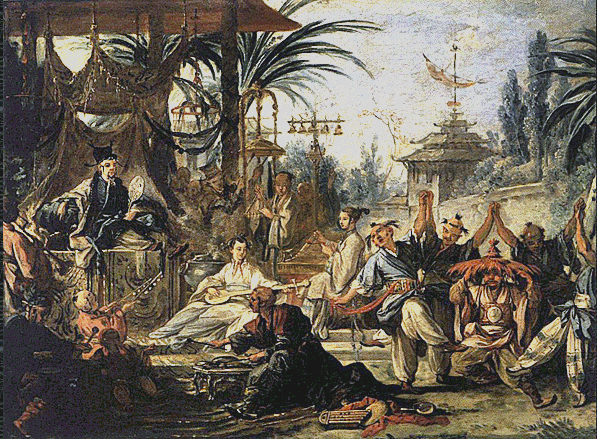
The original oil sketch by Boucher
that would have been used to create a production template for the Chinoiserie tapestry
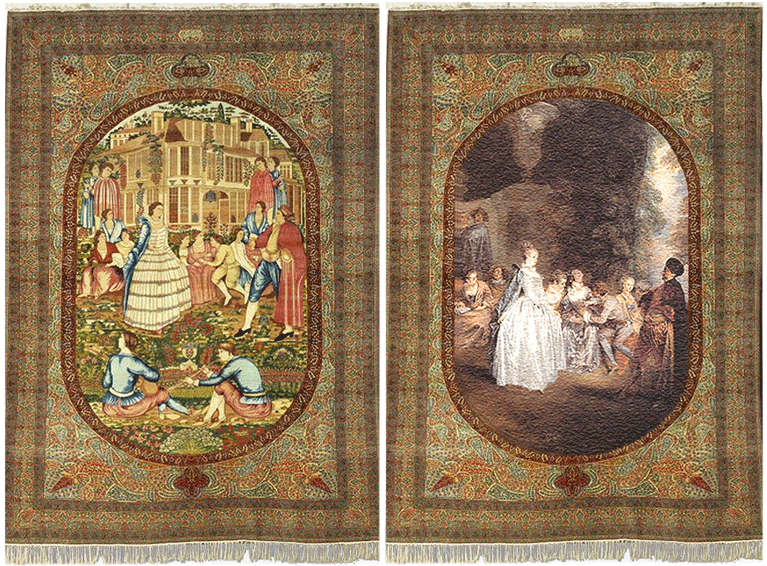
Weaving VS Painting:
Above (left) early 20th-century carpet woven in Kerman, Iran and modelled after an 18th-century
painting by renowned French artist Jean Antoine Watteau - as compared to (right) a simulation using
Watteau's original painting. Some of the notable differences between woven art vs painted art are
the fixed opacity, location and limited color palette available using dyed thread vs. the relative
translucency, color array and plastic nature of oil-based paint.
The Rococo Period
Rococo, or roccoco (Late Baroque), is the artistic movement and style encompassing most of the 18th century - at least up until the French Revolution (1789) - observable in the applied arts including painting, sculpture, architecture, interior design, decoration, literature, music, and theatre.
According to the Dictionary of the French Academy (1835), the term Rococo "usually refers to the kind of ornament, style and design associated with Louis XV's reign and the beginning of that of Louis XVI." As much a reaction against the grandeur, symmetry and strict regulation of the Baroque - as an embodiment of a new idealized apolitical, areligious paradigm, it was a logical outgrowth of the Age of Enlightenment.
The most renouned painters whose work embodied this style are first Jean-Antoine Watteau (1684-1721), and later François Boucher (1703-1770) and Jean-Honoré Fragonard (1732-1806). Though qualities such as more elegant, gallant, decorative, ornate and frivolous as well as less rigid, formal and symmetrical are present, there was no less an effort to render form realistically - to the contrary, academic art was at its zenith.
Academic Art
Academic art is the style and practice of applied art i.e. painting, drawing and sculpture as recognized and taught by European academies, and the art and artists influenced by the standards of the French Académie des Beaux-Arts during the 18th - 19th century specifically, which in turn was influenced by the Italian and Northern European Renaissance. The hallmark of this course of study consisted in the systematic training of the student in disciplines such as artistic anatomy, drawing and perspecive, for which the student would have to demonstrate a native proficiency to qualify.
Throughout the entire process,
competitions with a predetermined subject and a specific allotted period of time measured each
students' progress. The most famous of such competitions was the Prix de Rome - the winner awarded
a fellowship to study at the Villa Medici in Rome for
up to 5 years. The competition was grueling, involving several
stages before the final one, in which 10 competitors were sequestered in studios for 72 days to
paint their final history paintings.
Currently Nejad Rugs of Doylestown, PA is offering
the following antique French Aubusson Tapestry for sale:
More information about this tapestry: Photo detail, Authentication etc.
About:
Tabriz Antique Rugs | Heriz Antique Rugs | Mashhad Antique Rugs | Sarouk Antique Rugs | Kashan Antique Rugs
Kerman Antique Rugs | Serapi Antique Rugs | Bidjar Antique Rugs | Karabagh Antique Rugs | Senneh Antique Rugs
Bakhtiari & Antique Bakhtiari Rugs | Nain and Antique Nain Persian Rugs | Ziegler Mahal Antique Persian Rugs
Esfahan & Antique Esfahan Rugs | Qum Antique Rugs | Farahan Antique Rugs | Darjazin-Hamadan Antique Rugs
Hereke Antique Rugs | Akstafa Antique Rugs | Antique Gharajeh Rugs | Chichi Antique Rugs | Mudjar Antique Rugs
Kazak Antique Rugs | Shirvan Antique Rugs | Beluch Antique Rugs | Peking Antique Rugs | Kurdish Antique Rugs
Turkeman Antique Rugs | Dagestan Antique Rugs | Flemish Antique Tapestry | Antique Ming Chinese Rugs
French Aubusson Antique Tapestry
- after Francois Boucher